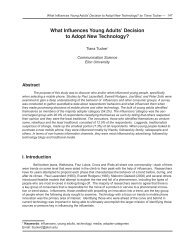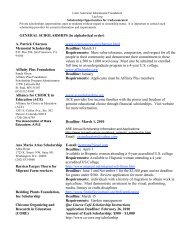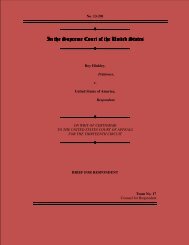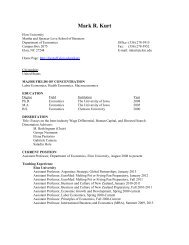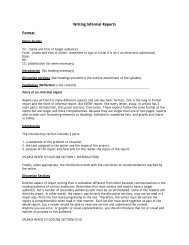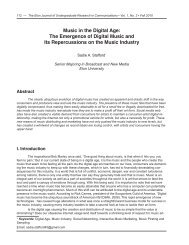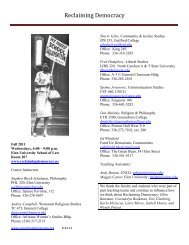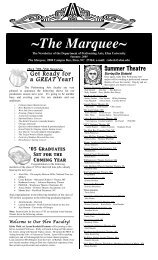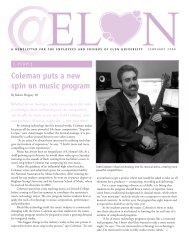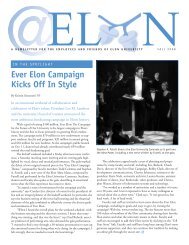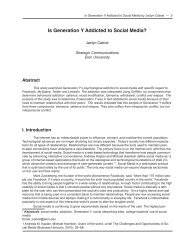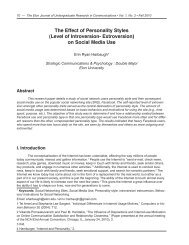The Influence of Rap/Hip-Hop Music: A Mixed ... - Elon University
The Influence of Rap/Hip-Hop Music: A Mixed ... - Elon University
The Influence of Rap/Hip-Hop Music: A Mixed ... - Elon University
Create successful ePaper yourself
Turn your PDF publications into a flip-book with our unique Google optimized e-Paper software.
<strong>The</strong> <strong>Influence</strong> <strong>of</strong> <strong>Rap</strong>/<strong>Hip</strong>-<strong>Hop</strong> <strong>Music</strong>: A <strong>Mixed</strong>-Method Analysis by Gretchen Cundiff — 71<br />
<strong>The</strong> <strong>Influence</strong> <strong>of</strong> <strong>Rap</strong>/<strong>Hip</strong>-<strong>Hop</strong> <strong>Music</strong>:<br />
A <strong>Mixed</strong>-Method Analysis on Audience Perceptions<br />
<strong>of</strong> Misogynistic Lyrics and the Issue <strong>of</strong> Domestic Violence<br />
Gretchen Cundiff *<br />
Strategic Communications<br />
<strong>Elon</strong> <strong>University</strong><br />
Abstract<br />
Using a qualitative content analysis and online survey, this research examined how college students<br />
perceive and respond to the portrayal <strong>of</strong> women when exposed to misogynistic lyrics. Based on cultivation<br />
theory, this study analyzed the lyrical content <strong>of</strong> popular rap and hip-hop songs (n=20) on Billboard’s “Hot<br />
100” chart between 2000 and 2010. Song lyrics were classified into one or more <strong>of</strong> the following coding<br />
categories: demeaning language, rape/sexual assault, sexual conquest and physical violence. <strong>The</strong>mes <strong>of</strong><br />
power over, objectification <strong>of</strong> and violence against women were identified as prevalent throughout the content<br />
analysis sample. Survey results indicated a positive correlation between misogynous thinking and rap/hip-hop<br />
consumption.<br />
I. Introduction<br />
This study examined the culture <strong>of</strong> rap/hip-hop music and how misogynistic lyrical messages influenced<br />
listeners’ attitudes toward intimate partner violence. Adams and Fuller (2006) define misogyny as the<br />
“hatred or disdain <strong>of</strong> women” and “an ideology that reduces women to objects for men’s ownership, use, or<br />
abuse” (p. 939). Popular American hip-hop and rap artists, such as Eminem, Ludacris and Ja Rule, have<br />
increasingly depicted women as objects <strong>of</strong> violence or male domination by communicating that “submission is<br />
a desirable trait in a woman” (Stankiewicz & Rosselli, 2008, p. 581). <strong>The</strong>se songs condone male hegemony in<br />
which “men find the domination and exploitation <strong>of</strong> women and other men to be not only expected, but actually<br />
demanded” (Prushank, 2007, p. 161). Thus, these messages glorify violence against women, including<br />
rape, torture and abuse, and foster an acceptance <strong>of</strong> sexual objectification and degradation <strong>of</strong> women (Russo<br />
& Pirlott, 2006). <strong>The</strong>se misogynistic themes first emerged in rap/hip-hop songs in the late 1980s and are especially<br />
apparent today with women being portrayed as sex objects and victims <strong>of</strong> sexual violence (Adams &<br />
Fuller, 2006; Russo & Pirlott, 2006).<br />
Young adults between the ages <strong>of</strong> 16 and 30 are the most likely age group to consume rap/hip-hop<br />
music, and in turn, may become desensitized to the derogatory lyrics condoning relationship violence and<br />
sexual aggression (Smith, 2005). Specifically, the college-aged demographic has been influenced by the<br />
prevalence <strong>of</strong> sexually explicit media and the negative images <strong>of</strong> women presented in hip-hop culture, which<br />
“teach men that aggression and violence are closely linked to cultural views <strong>of</strong> masculinity” (Wood, 2012, p.<br />
105). Furthermore, the physical abuse <strong>of</strong> women is celebrated in rap/hip-hop songs promoting “models <strong>of</strong><br />
masculinity that sustain and encourage misogyny” (Cobb & Boettcher, 2007, p. 3026).<br />
This paper evaluated the impact <strong>of</strong> cultivation theory and whether exposure to misogynistic rap<br />
* Keywords: misogyny, hip-hop culture, rap music, media effects, violent lyrics<br />
Email: gcundiff@elon.edu
72 — <strong>The</strong> <strong>Elon</strong> Journal <strong>of</strong> Undergraduate Research in Communications • Vol. 4, No. 1 • Spring 2013<br />
increases the acceptance <strong>of</strong> perpetrating violent acts against women (Johnson, Jackson, & Gatto, 1995).<br />
Also, this paper incorporated the disinhibition hypothesis in relation to how audiences become desensitized to<br />
media violence after repeated exposure (Rosenberry & Vicker, 2009). Analyzing the relationship between rap/<br />
hip-hop lyrical content and song popularity showed how audiences have responded to objectifying messages<br />
through their music consumption.<br />
II. Literature Review<br />
Issue <strong>of</strong> Domestic Violence<br />
Domestic violence is a pressing issue <strong>of</strong>ten deemed acceptable by the media, and thus, challenges<br />
men and women’s perceptions <strong>of</strong> how they should treat their partners in their relationships. Over the past two<br />
decades, the United Nations Commission on the Status <strong>of</strong> Women “reported a tremendous increase in the<br />
representation <strong>of</strong> violence against women, particularly sexual violence, in the media” (Stankiewicz & Rosselli,<br />
2008, p. 581). Studies suggest that increased exposure to misogynistic messages has desensitized audiences<br />
to the issue <strong>of</strong> intimate partner violence and fosters greater tolerance <strong>of</strong> male aggression (Barongan<br />
& Hall, 1996). <strong>The</strong> mass media portrays domestic violence both visually and aurally by normalizing the use<br />
<strong>of</strong> force in relationships, which correlates to the fact that “more than one in three women in the United States<br />
have been sexually coerced by a partner” (Nettleton, 2011, p. 140). <strong>The</strong>refore, it is not surprising that “men<br />
commit at least 90% <strong>of</strong> documented acts <strong>of</strong> physical intimate partner violence in the U.S.” by exerting control<br />
over women (Wood, 2012, p. 301).<br />
<strong>The</strong> ambiguity <strong>of</strong> what constitutes sexual assault or intimate partner violence contributes to public<br />
misperception <strong>of</strong> domestic violence. <strong>The</strong> Office <strong>of</strong> Violence Against Women defines domestic violence as a<br />
“pattern <strong>of</strong> abusive behavior in any relationship that is used by one partner to gain or maintain power and<br />
control over another intimate partner” (“What Is Domestic Violence?,” 2012). Physical, sexual and psychological<br />
actions or threats <strong>of</strong> abuse toward a partner are the most common forms <strong>of</strong> domestic violence (“What<br />
Is Domestic Violence?,” 2012). Domestic violence includes behaviors that “intimidate, manipulate, humiliate,<br />
isolate, frighten, terrorize, coerce, threaten, blame, hurt, injure, or wound someone” (“What Is Domestic<br />
Violence?” 2012). <strong>The</strong> National Violence Against Women Survey, conducted by Tjaden and Thoennes (2000),<br />
estimates that one in five women in the United States is physically assaulted in her lifetime and one in 13 is<br />
raped by an intimate partner (Russo & Pirlott, 2006).<br />
While women <strong>of</strong> all ages are at risk <strong>of</strong> experiencing domestic and sexual violence, those between the<br />
ages <strong>of</strong> 20-24 are most susceptible to experiencing nonfatal intimate partner violence (“Get the Facts: <strong>The</strong><br />
Facts,” 2007). According to a 2007 study by Laurel Crown and Linda Roberts, “one-half <strong>of</strong> college women<br />
in their senior year reported one or more unwanted sexual interactions during their college careers” (Wood,<br />
2012, p. 287). <strong>The</strong> perpetration <strong>of</strong> violent behavior can be explained using the cognitive learning theory,<br />
asserting, “individuals receive messages through society and media that shape relationship ideologies”<br />
(Bretthauer, Zimmerman, & Banning, 2006, p. 30). This study specifically analyzed college students’ views on<br />
the issue <strong>of</strong> domestic violence and its portrayal in popular rap/hip-hop music.<br />
Misogyny in <strong>Rap</strong>/<strong>Hip</strong>-<strong>Hop</strong> <strong>Music</strong><br />
In a recent content analysis <strong>of</strong> six types <strong>of</strong> media, Pardun, L’Engle, and Brown (2005) found that<br />
music, in particular, contained substantially more sexual content than any other media outlets. Sexually<br />
explicit and derogatory lyrics are especially apparent in rap music, which has been criticized for its graphic<br />
derogatory presentation <strong>of</strong> women using lyrics that objectify, exploit or victimize them (Weitzer & Kubrin, 2009;<br />
Cobb & Boettcher, 2007). Adams and Fuller (2006) assert that rap music reduces women to objects “that are<br />
only good for sex and abuse,” which “perpetuate ideas, values, beliefs, and stereotypes that debase women”<br />
(p. 940). This study also noted six themes common in misogynistic rap music, and further examined three<br />
<strong>of</strong> them: derogatory statements about women in relation to sex; statements involving violent actions toward<br />
women, particularly in relation to sex; and references <strong>of</strong> women as usable and discardable beings (Adams &<br />
Fuller, 2006).<br />
Armstrong (2001) conducted a content analysis <strong>of</strong> 490 rap songs from 1987 to 1993, in which 22%
<strong>The</strong> <strong>Influence</strong> <strong>of</strong> <strong>Rap</strong>/<strong>Hip</strong>-<strong>Hop</strong> <strong>Music</strong>: A <strong>Mixed</strong>-Method Analysis by Gretchen Cundiff — 73<br />
contained lyrics featuring violence against women including assault, rape and murder. His study classified<br />
rap songs into different categories in which rappers either pride themselves on sex acts appearing to harm<br />
women, justify other acts <strong>of</strong> violence, warn women who challenge male domination that they will be assaulted,<br />
and/or seem to invite male violence against women (Armstrong, 2001). Weitzer and Kubrin (2009) conducted<br />
a follow-up study analyzing the portrayal <strong>of</strong> women in 403 rap songs through a content analysis, in which<br />
themes <strong>of</strong> derogatory naming and shaming <strong>of</strong> women; sexual objectification <strong>of</strong> women; distrust <strong>of</strong> women;<br />
legitimation <strong>of</strong> violence against women; and celebration <strong>of</strong> prostitution and pimping appeared at the greatest<br />
frequency. Sexual objectification was found to occur in 67% <strong>of</strong> the misogynistic lyrics in their songs sampled<br />
(Weitzer & Kubrin, 2009). This study further examined the frequency <strong>of</strong> explicit music content found in the<br />
past decade’s worth <strong>of</strong> popular rap/hip-hop music. Furthermore, stereotyped gender roles emerged from lyrics<br />
containing sexual imagery that promote the “acceptance <strong>of</strong> women as sexual objects and men as pursuers <strong>of</strong><br />
sexual conquest,” (Martino, Collins, Elliott, Strachman, Kanouse, & Berry, 2006, p. 438).<br />
<strong>Influence</strong> on Audience Perceptions<br />
George Gerbner focused on violent television content and how audience exposure to these violent<br />
images influences their views and conception <strong>of</strong> social reality, by cultivating a “common view <strong>of</strong> the world”<br />
(Rosenberry & Vicker, 2009, pg. 165). As a result, Gerbner developed cultivation theory by examining how<br />
long-term exposure to violent media messages alters audience perceptions <strong>of</strong> violence in their everyday lives<br />
(Rosenberry & Vicker, 2009). This approach can be applied to all forms <strong>of</strong> media by interpreting individuals’<br />
reactions to violent content; thus, this study will incorporate cultivation theory in an analysis <strong>of</strong> misogynistic<br />
lyrics affecting listeners’ attitudes toward domestic violence (Rosenberry & Vicker, 2009).<br />
In reviewing more than five decades worth <strong>of</strong> research, Potter (1999) extended cultivation theory to<br />
determine the following effects <strong>of</strong> exposure to media violence:<br />
Exposure to violent portrayals in the media can lead to subsequent viewer aggression<br />
through disinhibition. Long-term exposure to media violence is related to aggression in a person’s<br />
life. Media violence is related to subsequent violence in society. Exposure to violence in<br />
the media can lead to desensitization. People exposed to many violent portrayals over time<br />
will come to be more accepting <strong>of</strong> violence. (Rosenberry & Vicker, 2009, p. 169)<br />
In turn, Dr. Edgar Tyson (2006) developed a 26-item instrument, the <strong>Rap</strong> <strong>Music</strong> Attitude and Perception<br />
(RAP) Scale, the “only tool available to access an individual’s attitude toward and perception <strong>of</strong> rap<br />
music lyrics” (p. 212). <strong>The</strong> RAP Scale contains three constructs: empowerment, artistic aesthetics and violent<br />
misogynistic. This study incorporated the empowerment and violent misogynistic constructs to measure “violent,<br />
sexist, and misogynistic images conveyed in the lyrics” to examine college students’ perceptions <strong>of</strong> the<br />
content through a survey (Gourdine & Lemmons, 2011, p. 65). Using a meta-analysis approach, Timmerman<br />
et. al (2008) found that “listening to music generates an effect on listeners consistent with the content <strong>of</strong> the<br />
music,” such as when rap/hip-hop artists communicate themes condoning “power over, objectification <strong>of</strong> and<br />
violence against women” (p. 303; Bretthauer et al., 2006, p. 42). This 2008 study applied the term “priming” to<br />
determine “whether music serves as a mechanism to ‘prime’ someone for subsequent actions and behaviors,”<br />
and in turn, react to, incorporate or reject the media content into the listener’s life (Timmerman et. al., 2008, p.<br />
307). While a correlation may exist between exposure to misogynistic music and audience attitudes regarding<br />
violent acts against women, a causal link cannot be demonstrated between listening habits and resulting<br />
misogynistic behavior (Baran & Davis, 2006, p. 331). <strong>The</strong>refore, the consumption <strong>of</strong> misogynistic music can<br />
influence audience perceptions <strong>of</strong> misogynistic content, but does not directly lead to “subsequent aggressive<br />
actions” (Timmerman et. al., 2008, p. 307).<br />
This study expanded upon previous research incorporating the RAP Scale, priming and cultivation<br />
theory to determine how college students’ perspectives on issues <strong>of</strong> domestic violence reflect misogynistic<br />
themes emphasized in explicit rap/hip-hop music.<br />
Research Questions<br />
This study explored whether consuming rap/hip-hop music containing misogynistic messages affects<br />
the attitudes <strong>of</strong> audiences regarding domestic violence.<br />
RQ. 1: How do college students perceive and respond to the portrayal <strong>of</strong> women when exposed to<br />
misogynistic lyrics?
74 — <strong>The</strong> <strong>Elon</strong> Journal <strong>of</strong> Undergraduate Research in Communications • Vol. 4, No. 1 • Spring 2013<br />
RQ. 2: Does gender impact how college students interpret misogynistic messages found within popular<br />
rap/hip-hop songs?<br />
III. Method<br />
This study used cultivation theory to examine the media effects <strong>of</strong> misogynistic rap and hip-hop music<br />
on shaping audience attitudes toward intimate partner violence. By incorporating a qualitative content analysis<br />
and an online survey, this study analyzed the lyrical content <strong>of</strong> popular rap and hip-hop songs found on<br />
Billboard’s “Hot 100” chart over the past decade. <strong>The</strong> sample <strong>of</strong> 20 songs was drawn from Billboard’s Year-<br />
End “Hot 100” singles list, which includes the most popular music from various music genres. <strong>The</strong>se were<br />
chosen due to the specific violent or objectifying terminology found within the lyrics <strong>of</strong> top-ranked rap and<br />
hip-hop songs during this study’s qualitative content analysis. <strong>The</strong> Billboard “Hot 100,” issued weekly by Billboard<br />
magazine, is the music industry’s standard for measuring song popularity in the United States based on<br />
radio airplay, online streaming activity, physical CD sales and digital downloads (“Billboard Hot 100”). Nielsen<br />
Soundscan compiles the “Hot 100” chart rankings based on weekly audience impressions starting the first<br />
week in December each year (“Billboard Hot 100”). Year-end chart totals are calculated in the final week <strong>of</strong><br />
November to determine the top 100 songs per year for all music genres combined (“Billboard Hot 100”).<br />
Cultivation <strong>The</strong>ory<br />
<strong>The</strong> meanings underlying the songs’ lyrical messages were analyzed through the lens <strong>of</strong> cultivation<br />
theory, which proposes “when people are exposed to media content or other socialization agents, they gradually<br />
come to cultivate or adopt beliefs about the world that coincide with the images they have been viewing<br />
or messages they have been hearing” (Gerbner, Gross, Morgan, & Signorielli, 1994, p. 22). Cultivation theory<br />
further asserts that the more audiences are exposed to factors such as sexual aggression, submission or<br />
violence in intimate relationships, the more they accept the objectification <strong>of</strong> women over time (Gerbner, et.<br />
al, 1994). This study specifically examined gendered audiences’ interpretation <strong>of</strong> misogynistic messages in<br />
popular rap/hip-hop songs to see if there were group differences in the effects <strong>of</strong> media content (Martino, et.<br />
al, 2006).<br />
Qualitative Content Analysis<br />
Content analysis is described as “a research technique for objective, systematic and quantitative<br />
description <strong>of</strong> the manifest content <strong>of</strong> communication” to investigate messages and reduce them into categories<br />
(Rosenberry & Vicker, 2009, pg. 42). According to Zhang & Wildemuth (2009), qualitative content analysis<br />
“pays attention to unique themes that illustrate the range <strong>of</strong> meanings <strong>of</strong> the phenomenon rather than the statistical<br />
significance <strong>of</strong> the occurrence <strong>of</strong> particular text or concepts” (p. 309). Using a qualitative content analysis<br />
guided by cultivation theory, this study examined the presence or absence <strong>of</strong> violent misogynistic lyrics<br />
found in 20 popular rap and hip-hop songs between 2000 and 2010. <strong>The</strong> song lyrics were obtained from various<br />
Internet sources (e.g., azlyrics.com) and coded line by line. Songs were classified into one or more <strong>of</strong> the<br />
following coding categories based on images and messages conveyed in lyrics: demeaning language, rape/<br />
sexual assault, sexual conquest and/or physical violence. Songs were also labeled according to their level <strong>of</strong><br />
misogynistic content, based on the number <strong>of</strong> categories into which the lyrics were coded: high, medium or<br />
low levels <strong>of</strong> misogyny. <strong>The</strong> coding categories--derogatory naming and shaming <strong>of</strong> women; sexual objectification<br />
<strong>of</strong> women; and legitimation <strong>of</strong> violence against women--were adopted from Weitzer and Kubrin’s (2009)<br />
content analysis study and incorporated into this present study.<br />
Description <strong>of</strong> coding categories<br />
• Songs referencing acts <strong>of</strong> physical violence toward women were coded as such if they contained<br />
words including: slap, punch, push, beat, hit, bleeding, pain, throw, pin, tie, whippings, murder, etc.<br />
• Songs insinuating rape or sexual assault were coded as such if they contained words/phrases including:<br />
fuck, rape, assault, cut up, bust open, etc.
<strong>The</strong> <strong>Influence</strong> <strong>of</strong> <strong>Rap</strong>/<strong>Hip</strong>-<strong>Hop</strong> <strong>Music</strong>: A <strong>Mixed</strong>-Method Analysis by Gretchen Cundiff — 75<br />
• Songs labeling women in derogatory ways were coded as such for using demeaning language containing<br />
the following words: pussy, bitch, pimp, nigga, etc.<br />
• Songs portraying sexual conquest were coded as such if they contained phrases including: love em/<br />
leave em, feel the pain, don’t have to fight back, etc.<br />
Frequency/emphasis <strong>of</strong> misogynistic lyrics<br />
• Songs were first coded for their misogynistic terminology and then evaluated for their amount <strong>of</strong><br />
misogynistic content and labeled accordingly.<br />
Survey<br />
* One to two misogynistic lyrical references= low level <strong>of</strong> misogyny<br />
* Three to four misogynistic lyrical references= medium level <strong>of</strong> misogyny<br />
* Five or more misogynistic lyrical references= high level <strong>of</strong> misogyny<br />
In conjunction with performing a content analysis, this study administered a survey using Survey Monkey<br />
to gauge college students’ perceptions <strong>of</strong> the portrayal <strong>of</strong> intimate partner violence in the songs examined<br />
below. Surveys involve a correlational method by which researchers measure two or more variables and<br />
examine relationships between them (Rosenberry & Vicker, 2009). This 12-question survey was disseminated<br />
to a convenience, nonprobability sample <strong>of</strong> 62 <strong>Elon</strong> <strong>University</strong> students, 52 women and 10 men, representing<br />
sophomores through seniors. <strong>The</strong>se students were asked via email or social media to click a link to a Survey<br />
Monkey questionnaire page. <strong>The</strong> first six questions asked respondents general questions about their views<br />
on rap/hip-hop music and interpretation <strong>of</strong> musical content. This involved a series <strong>of</strong> multiple-choice questions<br />
evaluating audience listening behavior; the emphasis on lyrics versus melody in this genre; the presence <strong>of</strong><br />
<strong>of</strong>fensive or degrading lyrical content; and the perception <strong>of</strong> rap/hip-hop artists overall. <strong>The</strong> remaining questions,<br />
dealing with misogynistic themes apparent in popular rap/hip-hop songs, were prefaced with a disclaimer:<br />
for purposes <strong>of</strong> this study, lyrics are considered misogynistic if they support, glorify, justify, or normalize the<br />
objectification, exploitation, or victimization <strong>of</strong> women. This included an adapted version <strong>of</strong> the definition <strong>of</strong><br />
misogyny, as the “promotion, glamorization, support, humorization, justification, or normalization <strong>of</strong> oppressive<br />
ideas about women” to ensure that respondents were familiar with the term (Adams & Fuller, 2006, p. 940).<br />
Respondents were presented with multiple choice and Likert scale questions examining <strong>of</strong>fensiveness in misogynistic<br />
lyrics; the prevalence <strong>of</strong> misogynistic lyrics in a sample <strong>of</strong> rap/hip-hop songs; and attitudes toward<br />
the issue <strong>of</strong> domestic violence.<br />
<strong>The</strong>se questions examined specifically how the college-aged demographic was influenced by the<br />
prevalence <strong>of</strong> derogatory lyrics condoning violent sexual behavior. Students were asked to respond to a list<br />
<strong>of</strong> statements inquiring about their listening habits; opinions on rap and hip-hop songs; knowledge <strong>of</strong> domestic<br />
violence issues; exposure to misogynistic lyrics; and attitudes on sexism. Five <strong>of</strong> these categories were<br />
adapted from Tyson’s 2006 RAP scale, measuring interpretations <strong>of</strong> gender using empowerment and violent<br />
misogynistic constructs.<br />
IV. Findings<br />
Part I: Content Analysis<br />
Using a content analysis method, this study analyzed the lyrics <strong>of</strong> 20 rap/hip-hop songs included in<br />
Billboard’s Year-End “Hot 100” singles list ranging from 2000-2010 (Refer to Table 1 on page 76). <strong>The</strong> sample<br />
set <strong>of</strong> music was selected based on the misogynistic themes appearing within the lyrics <strong>of</strong> these popular hits,<br />
all <strong>of</strong> which were labeled as explicit.
76 — <strong>The</strong> <strong>Elon</strong> Journal <strong>of</strong> Undergraduate Research in Communications • Vol. 4, No. 1 • Spring 2013<br />
Table 1. Billboard “Hot 100” Singles Year-End (2001-2010)<br />
<strong>The</strong> Real Slim<br />
Shady<br />
Song Artist Genre Year Rank<br />
Eminem <strong>Hip</strong> hop 2000 51<br />
Big Pimpin’ Jay-Z and UGK East coast hip hop 2000 60<br />
Shake Ya Ass Mystikal <strong>Hip</strong> hop 2000 68<br />
<strong>The</strong> Next Episode<br />
Danger (Been So<br />
Long)<br />
Dr. Dre and Snoop<br />
Dogg<br />
West coast hip hop 2000 76<br />
Mystikal and Nivea <strong>Hip</strong> hop 2001 58<br />
Livin’ It Up Ja Rule and Case <strong>Hip</strong> hop 2001/2002 79/76<br />
Southern Hospitality<br />
Lights, Camera,<br />
Action<br />
Move Bitch<br />
Ludacris Southern rap 2001 77<br />
Mr. Cheeks <strong>Hip</strong> hop 2002 49<br />
Ludacris, Mystikal<br />
and I-20<br />
Southern hip hop 2002 55<br />
Superman Eminem Alternative hip hop 2003 98<br />
Splash Waterfalls Ludacris Dirty rap 2004 42<br />
Lovers & Friends<br />
Lil Jon, Usher &<br />
Ludacris<br />
Dirty hip hop 2005 25<br />
Some Cut Trillville & Cutty <strong>Hip</strong> hop 2005 49<br />
Lean Wit It, Rock<br />
Wit It<br />
Dem Franchize<br />
Boyz<br />
Southern hip hop 2006 25<br />
Touch It Busta Rhymes East Coast hip hop 2006 73<br />
When I’m Gone Eminem Conscious hip hop 2006 90<br />
Crack a Bottle<br />
Eminem, Dr. Dre<br />
and 50 Cent<br />
Hardcore hip hop 2009 47<br />
Every Girl Young Money <strong>Hip</strong> hop/dirty rap 2009 67<br />
Love the Way You<br />
Lie<br />
Eminem and Rihanna<br />
<strong>Hip</strong> hop 2010 7<br />
Bottoms Up Trey Songz <strong>Hip</strong> hop/R&B 2010 52<br />
Coding Outcome. As shown in Figure 1, eight <strong>of</strong> the songs (40%) sampled were coded strictly for<br />
physical violence; none <strong>of</strong> the songs were coded for strictly rape/sexual assault; two songs (10%) were coded<br />
strictly for sexual conquest; and two songs<br />
(10%) were coded strictly for demeaning<br />
language. Eight <strong>of</strong> the songs (40%) contained<br />
lyrics coded into more than one category <strong>of</strong><br />
misogynistic content. Three songs (15%) were<br />
coded for the demeaning language and rape/<br />
sexual assault categories. Two songs (10%)<br />
were coded for the rape/sexual assault, sexual<br />
conquest and demeaning language categories.<br />
One song was coded for the physical violence,<br />
rape/sexual assault and sexual conquest<br />
categories. In addition, one song was coded for<br />
the demeaning language and sexual conquest<br />
Figure 1. Coding categories
<strong>The</strong> <strong>Influence</strong> <strong>of</strong> <strong>Rap</strong>/<strong>Hip</strong>-<strong>Hop</strong> <strong>Music</strong>: A <strong>Mixed</strong>-Method Analysis by Gretchen Cundiff — 77<br />
categories, along with one song coded for the rape/sexual assault and physical violence categories.<br />
As shown in Figure 2, Half <strong>of</strong> the songs sampled (n=10) were coded for low levels <strong>of</strong> misogyny; eight<br />
songs (40%) for medium levels <strong>of</strong> misogyny; and two <strong>of</strong> the songs<br />
(10%) for high levels <strong>of</strong> misogyny. <strong>The</strong>re were a total <strong>of</strong> 55 misogynistic<br />
references in all the individual song’s misogynistic lyrical content.<br />
Five songs by rapper Eminem were included in the coding<br />
sample, which represents one-fourth <strong>of</strong> all songs sampled. Three<br />
songs by rap/hip-hop artist Ludacris were included in the coding<br />
sample, representing 15% <strong>of</strong> all songs sampled. <strong>Rap</strong>per Mystikal was<br />
included in the sample for three <strong>of</strong> his songs, 15% <strong>of</strong> the study sampling.<br />
All <strong>of</strong> the songs by Eminem and Ludacris featured in the sample<br />
included lyrics depicting physical violence against women.<br />
Three <strong>of</strong> the songs (15%) fell into the rap genre, with the rest<br />
classified as hip-hop music. Eminem was the only Caucasian artist featured<br />
in the song sampling, and African American artists performed the<br />
Figure 2. Levels <strong>of</strong> Misogyny<br />
remaining 15 sampled songs (75%). Solo artists performed half (n=10)<br />
<strong>of</strong> the songs in the sample. Two (10%) <strong>of</strong> the songs sampled included a<br />
male/female artist combination, “Danger (Been So Long)” by Mystikal and Nivea and “Love the Way You Lie”<br />
by Eminem and Rihanna.<br />
Songs containing misogynistic lyrics appeared in the sample with the greatest frequency during the<br />
first half <strong>of</strong> the decade (2000-2005). Songs featured on the Billboard “Hot 100” chart between 2000 and 2001<br />
(n=7) contained the greatest concentration <strong>of</strong> misogynistic lyrics over a two-year period. Four out <strong>of</strong> seven<br />
songs (57.1%) during this timeframe contained two or more references to misogyny in their lyrics. Additionally,<br />
all <strong>of</strong> the songs sampled from 2006, which accounted for 15% <strong>of</strong> the total sample frame, featured lyrics suggesting<br />
physical violence against women. (For more detail, refer to Appendix 1 to view the coding sheet used<br />
in this study.)<br />
Songs referencing acts <strong>of</strong> physical violence toward women. <strong>The</strong> artists whose songs contained lyrics<br />
strictly coded under the physical violence category included Eminem; Ludacris, Mystikal and I-20; Dem Franchize<br />
Boyz; Busta Rhymes; and Rihanna. <strong>The</strong>re were 17 references to physical violence within this song sample, which are<br />
denoted with dotted lines, and the song containing the most references was Eminem and Rihanna’s “Love the Way You<br />
Lie” (n=4).<br />
<strong>The</strong> following are lyrics from Eminem’s songs included in the sample that glorify physical violence<br />
toward women and included between one to four misogynistic references:<br />
• “<strong>The</strong> Real Slim Shady”- Jaws all on the floor, like Pam, like Tommy just burst in the door and started<br />
whoopin her ass worse then before.<br />
• “Superman”- Don’t put out, I’ll put you out, won’t get out, I’ll push you out. <strong>The</strong>re goes another lawsuit,<br />
leave handprints all across you. Put anthrax on a tampax, and slap you till you can’t stand.<br />
• “When I’m Gone”- What happens when you become the main source <strong>of</strong> her pain? And put hands on<br />
her mother, who’s a spitting image <strong>of</strong> her. Daddy it’s me, help Mommy, her wrists are bleeding.<br />
• “Love the Way You Lie”- Just gonna stand there and watch me burn, But that’s alright because I like<br />
the way it hurts, Just gonna stand there and hear me cry, You push, pull each other’s hair, scratch, claw, hit<br />
‘em. Throw ‘em down, pin ‘em. Im’a tie her to the bed and set this house on fire.”<br />
<strong>The</strong> following lyrics from individual/group artists also contain one or more references in relation to<br />
men’s perpetrating violent physical acts toward women:<br />
• Ludacris’ “Southern Hospitality”- Lie through your teeth you could find your mouth, cold and rip out<br />
ya tongue cause <strong>of</strong> what ya mouth, told.<br />
• Ludacris, Mystikal and I-20’s “Move Bitch”- “I’ma ‘bout to punch yo...lights out”<br />
• Dem Franchize Boyz’s “Lean Wit It, Rock Wit It”- Rock so damn hard, u break your spleen wit it,<br />
Perfect example watch me make your face beat up my hands.<br />
• Busta Rhyme’s “Touch It”- I’ma hit you and your ma. and ima hit you where you stand.<br />
Songs labeling women in derogatory ways using demeaning language. <strong>The</strong> artists whose songs
78 — <strong>The</strong> <strong>Elon</strong> Journal <strong>of</strong> Undergraduate Research in Communications • Vol. 4, No. 1 • Spring 2013<br />
contained lyrics strictly coded under the demeaning language category were Young Money and Trey Songz.<br />
<strong>The</strong>re were five total references in the songs’ lyrics labeling women in derogatory ways.<br />
• Young Money’s “Every Girl” - Open up her legs then filet mignon that pussy, I’m a get in and on that<br />
pussy, If she let me in I’m a own that pussy.<br />
• Trey Songz’s “Bottoms Up”- If a bitch try to get cute ima stomp her. Throw alotta money at her then<br />
yell fuck her.<br />
Songs portraying sexual conquest. <strong>The</strong> artists whose songs contained lyrics strictly coded under<br />
the sexual conquest category were Ja Rule and Case, and Ludacris. <strong>The</strong>re were two total references in the<br />
songs’ lyrics that represented men using women only for their sexual value.<br />
• Ja Rule and Case’s “Livin It Up”- I got a stick, I’ll ride right next to you. Do a doughnut, and cut, and<br />
I’ll open it up.<br />
• Ludacris’ “Splash Waterfalls”- You better not <strong>of</strong> came, she want to feel the pain.<br />
Songs coded for two or more categories. <strong>The</strong> artists whose songs contained lyrics coded for the<br />
demeaning language and rape/sexual assault categories included Dr. Dre and Snoop Dogg; Mystikal and<br />
Nivea; and Trillville & Cutty. <strong>The</strong> underlined words were coded under the rape/sexual assault categories, and<br />
bolded words were coded under the demeaning language category. <strong>The</strong>re were 10 total instances <strong>of</strong> referring<br />
to women in misogynistic ways in the combined categories above, and the song containing the most references<br />
was Mystikal and Nivea’s “Danger (Been So Long)” (n=5).<br />
• Dr. Dre and Snoop Dogg’s “<strong>The</strong> Next Episode”- And if yo’ ass get cracked, bitch shut yo’ trap.<br />
• Mystikal and Nivea’s “Danger (Been So Long)”- Leave that pussy smoking. If you gonna lose something.<br />
<strong>The</strong>n bend over, and bust that pussy open. <strong>The</strong> pussy cutter.<br />
• Trillville and Cutty’s “Some Cut”- Can a nigga get in them guts (them guts)? Cut you up like you ain’t<br />
been cut (been cut). While I’m beatin and tearin down your walls (oh yeah). It’s no limits to what we do, cause<br />
tonight we cutting, gut busting. I’m digging in your walls something vicious.<br />
<strong>The</strong> artists whose songs contained lyrics coded for the rape/sexual assault, sexual conquest and<br />
demeaning language categories were Jay-Z and UGK, and Mystikal. <strong>The</strong> underlined words were coded under<br />
the rape/sexual assault category, bolded words were coded under the demeaning language category and<br />
double underlined words were coded under the sexual conquest category. <strong>The</strong>re were 13 total references for<br />
the above category, and the song containing the most references was Mystikal’s “Shake Ya Ass” (n=9). This<br />
also made it the most misogynistic song overall in the entire coding scheme.<br />
• Jay-Z and UGK’s “Big Pimpin”- You know I - thug em, fuck em, love em, leave em. Cause I don’t<br />
fuckin need em. In the cut where I keep em til I need a nut, til I need to beat the guts.<br />
• Mystikal’s “Shake Ya Ass”- Pay ya fare, fix ya hair, throw that pussy. I got a job for you - the braided<br />
up pimp is back. Break them handcuffs, fuck you nigga move somethin. And I’ve been beatin that pussy up<br />
now it’s smooth fuckin.<br />
Mr. Cheek’s “Lights, Camera, Action” was coded for the demeaning language and sexual conquest<br />
categories. <strong>The</strong> bolded word was coded under the demeaning language category, and the double underlined<br />
phrase was coded under the sexual conquest category.<br />
buns.<br />
• Booties dancin ‘round a nigga and I’m killin one. Killin one from the top <strong>of</strong> the stash and I’m feelin<br />
Lil Jon, Usher & Ludacris’ “Lovers & Friends” was coded into the rape/sexual assault, sexual conquest<br />
and physical violence categories. <strong>The</strong> underlined words were coded under the rape/sexual assault<br />
category, double underlined phrases were coded under the sexual conquest category and the dotted-lined<br />
phrase was coded under the physical violence category.<br />
• Be a good girl now, turn around, and get these whippings. You know you like it like that, you don’t<br />
have to fight back, Here’s a pillow - bite . . . that.<br />
Eminem, Dr. Dre and 50 Cent’s “Crack a Bottle” was coded into the rape/sexual assault and physical<br />
violence categories. <strong>The</strong> underlined words were coded under the rape/sexual assault category, and the<br />
dotted-lined phrase was coded under the physical violence category.<br />
• <strong>The</strong> moment you’ve all been waiting for. In this corner: weighing 175 pounds, with a record <strong>of</strong> 17<br />
rapes, 400 assaults, and 4 murders, <strong>The</strong> undisputed, most diabolical villain in the world: Slim Shady.
Part II: Survey<br />
<strong>The</strong> <strong>Influence</strong> <strong>of</strong> <strong>Rap</strong>/<strong>Hip</strong>-<strong>Hop</strong> <strong>Music</strong>: A <strong>Mixed</strong>-Method Analysis by Gretchen Cundiff — 79<br />
In order to evaluate college students’ attitudes toward and perception <strong>of</strong> misogynistic rap/<br />
hip-hop music, this study conducted a non-probability survey administered via Survey Monkey. Sixty-two<br />
<strong>Elon</strong> <strong>University</strong> students, 52 women and 10 men, ranging in academic year from sophomores to seniors,<br />
responded to the 12-question survey. <strong>The</strong> survey was designed to gauge how survey respondents perceive<br />
and respond to the issue <strong>of</strong> domestic violence and whether they feel popular rap/hip-hop music has positively<br />
or negatively influenced their views. This study specifically examined gendered differences to determine the<br />
effect <strong>of</strong> misogynistic lyrical content on these audiences and their views on the portrayal <strong>of</strong> women in popular<br />
rap/hip-hop songs. <strong>The</strong> influence <strong>of</strong> factors including music genre, artist gender and artist race was considered<br />
when analyzing relationships between music consumption and gender. (For more detail, refer to Appendix<br />
II to view the survey questions asked in this study.)<br />
Views on rap/hip-hop music and interpretation <strong>of</strong> musical content. Six out <strong>of</strong> ten male respondents<br />
rarely listen to rap/hip-hop music in comparison to only 25% <strong>of</strong> female respondents (n= 13). <strong>The</strong><br />
majority <strong>of</strong> female respondents (65.4%) frequently or sometimes listen to rap/hip-hop music. Half <strong>of</strong> male<br />
respondents (n=5) pay equal amounts <strong>of</strong> attention to the instrumental aspects and lyrics/messages when<br />
listening to rap/hop-hop music, compared to 28.8% <strong>of</strong> female respondents (n=15). Over half <strong>of</strong> female respondents<br />
(n=30) listen to the instrumental aspects <strong>of</strong> rap/hip-hop music the most. Roughly 20% (n=11) <strong>of</strong> female<br />
respondents hold positive attitudes toward rap/hip-hop music, while no male respondents held similar views.<br />
Sixty percent <strong>of</strong> male respondents hold negative attitudes toward this music genre, compared to only 23.1%<br />
<strong>of</strong> female respondents (n=12) with similar views. A majority <strong>of</strong> both male and female respondents (n=58) feel<br />
rap/hip-hop music is more <strong>of</strong>fensive to women than men.<br />
When evaluating a list <strong>of</strong> terms this study identified as degrading to women, 71.2% <strong>of</strong> female respondents<br />
(n=37) considered the word “bitch” degrading compared to all the male respondents (n=10). Both male<br />
and female respondents held similar views by labeling “pussy” and the “N” word as the most degrading terms,<br />
93.5% and 90.3% <strong>of</strong> the time respectively. Roughly 30% <strong>of</strong> respondents (n=20) considered “fuck” and “pimp”<br />
as the least degrading words out <strong>of</strong> the sample. Given a list <strong>of</strong> 16 popular rap/hip-hop artists, respondents<br />
were asked to determine which <strong>of</strong> the performers they believed perpetrated negative views about women<br />
through their songs lyrics. Nearly half <strong>of</strong> male respondents (n=4) compared with roughly 70% <strong>of</strong> female respondents<br />
(n=30) felt Snoop Dogg perpetrates negative attitudes about women in his songs. Three quarters<br />
<strong>of</strong> male respondents (n=6) indicated that Ja Rule also incorporates misogynistic views in his music compared<br />
with 21.4% <strong>of</strong> female respondents (n=9). Almost 60% <strong>of</strong> total respondents (n=37) consider 50 Cent to be the<br />
most misogynistic artist overall.<br />
<strong>The</strong> prevalence <strong>of</strong> misogynistic themes in rap/hip-hop music. Both men and women agreed that<br />
the legitimation <strong>of</strong> violence against women is the most <strong>of</strong>fensive aspect <strong>of</strong> misogynistic lyrics in rap/hip-hop<br />
songs, with over half <strong>of</strong> respondents (n=34) expressing these views. <strong>The</strong> sexual objectification <strong>of</strong> women and<br />
the derogatory naming and shaming <strong>of</strong> women were also considered <strong>of</strong>fensive attributes <strong>of</strong> misogynistic lyrics.<br />
Respondents were then asked to rank the list <strong>of</strong> 20 songs analyzed in the content analysis portion <strong>of</strong> this<br />
study, based on their misogynistic lyrical content on a scale <strong>of</strong> 1 (not at all misogynistic) to 5 points (extremely<br />
misogynistic). Respondents considered “Every Girl” by Young Money the most misogynistic song, with an average<br />
<strong>of</strong> 4.36 points based on 11 total responses, followed by Ludacris’ “Move Bitch,” with an average ranking<br />
<strong>of</strong> four based on 34 total responses. Eminem’s “When I’m Gone” was considered the least misogynistic song,<br />
with an average <strong>of</strong> 2.22 points based on 18 total responses, followed by his song “<strong>The</strong> Real Slim Shady,” with<br />
an average <strong>of</strong> 2.44 points based on 34 responses. <strong>The</strong> average number <strong>of</strong> respondents to rank songs was<br />
9.25, and the average rating for the sample was 3.21 points per song.<br />
Respondents also ranked the degree to which they feel exposure to popular rap/hip-hop songs shape<br />
audience attitudes toward the issue <strong>of</strong> domestic violence on a scale <strong>of</strong> 1 (not at all) to 5 (significantly). Over<br />
half <strong>of</strong> respondents (n=35) felt exposure to popular rap/hip-hop songs moderately or significantly shapes<br />
audience attitudes toward the issue <strong>of</strong> domestic violence. In addition, respondents were asked to state their<br />
level <strong>of</strong> agreement/disagreement on a scale <strong>of</strong> 1 (strongly disagree) to 5 (strongly agree) based on a list <strong>of</strong><br />
12 statements involving the depiction <strong>of</strong> violence toward women in rap/hip-hop music; the portrayal <strong>of</strong> hip hop<br />
culture in society; and the genre’s implications on shaping attitudes toward domestic violence in the United<br />
States. Responses by men and women were fairly consistent across the board in terms <strong>of</strong> supplying comparable<br />
levels <strong>of</strong> agreement/disagreement.<br />
<strong>The</strong> majority <strong>of</strong> respondents (n=44) agreed or strongly agreed that rap/hip-hop music encourages
80 — <strong>The</strong> <strong>Elon</strong> Journal <strong>of</strong> Undergraduate Research in Communications • Vol. 4, No. 1 • Spring 2013<br />
disrespectful attitudes toward women, along with a majority <strong>of</strong> respondents (n=48) who agreed or strongly<br />
agreed that most rap/hip-hop music suggests women are just for male sexual satisfaction. Almost three-quarters<br />
<strong>of</strong> respondents (n=44) felt rap/hip-hop music does not provide positive messages for its listeners, while<br />
46 respondents stated that rap/hip-hop music does not reflect the realities <strong>of</strong> intimate partner violence. Over<br />
half <strong>of</strong> respondents (n=33) felt rap/hip-hop music promotes aggressive and violent behaviors toward women,<br />
and exactly half <strong>of</strong> respondents (n=31) agreed or strongly agreed that rap/hip-hop music glorifies domestic<br />
violence. More than two-thirds <strong>of</strong> respondents (n=42) agreed or strongly agreed that explicit rap/hip-hop<br />
music is <strong>of</strong>fensive, and a majority <strong>of</strong> respondents (n=45) believe that sexism in rap/hip-hop music contributes<br />
to sexist behavior. All respondents agreed that misogynistic lyrics are prevalent in rap/hip-hop music to some<br />
extent, while almost all respondents (n=59) consider domestic violence a pressing issue in the United States.<br />
Only ten respondents disagreed that rap/hip-hop artists intend to degrade women through their lyrics, while<br />
almost half <strong>of</strong> respondents (n=29) agreed or strongly agreed that college-aged women are the most susceptible<br />
to experiencing gendered violence.<br />
Using crosstabs to analyze relationships. In order to determine subgroup differences regarding<br />
how misogynistic rap/hip-hop music affects gendered audiences, this study cross-tabbed listening habits <strong>of</strong><br />
male and female respondents to other variables. This study interpreted survey results based on the listening<br />
habits <strong>of</strong> respondents and corresponding exposure to misogynistic lyrics in this music. Of those who frequently<br />
listen to rap/hip-hop music (n=14), no respondents claimed to have a negative attitude toward it. This<br />
contrasts to those who rarely listen to rap/hip-hop music (n=19), <strong>of</strong> which no respondents claimed to have a<br />
positive attitude toward this music. Of those who listen to rap/hip-hop music for the lyrical/message aspect <strong>of</strong><br />
it (n=8), 37. 5% <strong>of</strong> respondents believe exposure to these songs significantly shapes audiences attitudes toward<br />
the issue <strong>of</strong> domestic violence. In addition, all respondents (n=8) who listen to rap/hip-hop music for the<br />
lyrics agreed or strongly agreed that most rap/hip-hop music suggests women are just for male sexual satisfaction.<br />
<strong>The</strong> study determined the greater the frequency with which audiences listen to rap/hip-hop music, the<br />
more they feel exposure shapes audience attitudes regarding domestic violence. <strong>The</strong> final cross-tab comparing<br />
listening habits with views <strong>of</strong> misogynistic lyrics found all respondents who frequently listen to rap/hip-hop<br />
music (n=14) also agreed or strongly agreed that misogynistic lyrics are prevalent in rap/hop-hop music.<br />
Part III: Comparing Methods<br />
In order to evaluate consistency between the content analysis outcome and survey results, both<br />
methods were compared to determine similarities and differences between the content coding results and respondent<br />
perceptions <strong>of</strong> the study’s 20-song sample. When analyzing misogynistic lyrical content, half <strong>of</strong> the<br />
songs included in both measures <strong>of</strong> analysis were considered equally misogynistic. However, there were several<br />
discrepancies between survey respondents’ views and the content analysis. Survey respondents found<br />
the songs “Southern Hospitality,” “Lights, Camera, Action,” “Move Bitch,” “Splash Waterfalls,” and “Touch It”<br />
more misogynistic than the content analysis coding. In the songs coded for medium levels <strong>of</strong> misogyny, survey<br />
respondents considered “Some Cut” and “When I’m Gone” as not misogynistic, while rating “Every Girl”<br />
much more so. Survey respondents rated “Shake Ya Ass,” which contained the most misogynistic references<br />
<strong>of</strong> all songs (n=9) coded in the sample, not as highly for misogynistic content. “Danger (Been So Long)” was<br />
also rated much lower by survey respondents for misogynistic levels than its high level <strong>of</strong> misogynistic content<br />
coded in the content analysis. Survey respondents labeled Eminem, Snoop Dogg, Ludacris, 50 Cent, Lil Jon<br />
and Young Money as the artists perpetrating the most misogynistic messages in their music. This corresponds<br />
with Eminem and Ludacris having the most songs included in the coding sample for misogynistic content.<br />
V. Conclusion<br />
Cultivation theory is supported by this paper’s findings, which found continued audience exposure<br />
to misogynistic lyrics in popular rap/hip-hop music influences college students’ attitudes toward the issue<br />
<strong>of</strong> domestic violence. This study’s content analysis approach to examining song lyrics <strong>of</strong> the most popular<br />
rap/hip-hop songs on Billboard’s “Hot 100” chart between 2000 and 2010 found messages communicating<br />
themes <strong>of</strong> power over, objectification <strong>of</strong> and violence against women to be prevalent across the sample selections<br />
(Bretthauer et al., 2006). This study’s findings are comparable to Bretthauer et al.’s (2006) study, which<br />
also uses a qualitative content analysis method to examine all top 20 popular music songs from 1998 through
<strong>The</strong> <strong>Influence</strong> <strong>of</strong> <strong>Rap</strong>/<strong>Hip</strong>-<strong>Hop</strong> <strong>Music</strong>: A <strong>Mixed</strong>-Method Analysis by Gretchen Cundiff — 81<br />
2003 on the Billboard “Hot 100” chart. Both studies conclude the theme appearing with the greatest frequency<br />
throughout the song samples is violence against women; this study’s survey results indicate that respondents<br />
consider the legitimation <strong>of</strong> violence against women the most <strong>of</strong>fensive theme in rap/hip-hop songs.<br />
Over half <strong>of</strong> survey respondents expressed that exposure to popular rap/hip-hop songs moderately<br />
or significantly shapes audience attitudes toward the issue <strong>of</strong> domestic violence. This supports the finding<br />
that “misogynistic music also serves as a means to desensitize individuals to sexual harassment, exploitation,<br />
abuse, and violence toward women” and “legitimizes the mistreatment and degradation <strong>of</strong> women” (Adams<br />
& Fuller, 2006, p. 953). Exposure to misogynistic messages in rap/hip-hop music has also been shown to<br />
“increase hostile and aggressive thoughts,” which may correlate to “more permanent hostility toward women”<br />
(Russo & Pirlott, 2006, p. 190). More than half <strong>of</strong> survey respondents believe rap/hip-hop music promotes<br />
aggressive and violent behaviors toward women; in addition, a majority <strong>of</strong> respondents feel this genre’s messages<br />
encourage disrespectful attitudes toward women.<br />
Listening to misogynistic content may also attribute to listeners’ “expression <strong>of</strong> similar attitudes in<br />
their own lives, including accepting the objectification <strong>of</strong> women” (Dixon, Zhang, & Conrad, 2009, p. 348).<br />
Half <strong>of</strong> survey respondents agree or strongly agree that rap/hip-hop music glorifies domestic violence, and<br />
when these messages are conveyed to listeners, it may contribute to the “creation <strong>of</strong> a social climate in which<br />
violence is viewed as acceptable” (Adams & Fuller, 2006, p. 953). <strong>The</strong>refore, rap/hip-hop music’s portrayal <strong>of</strong><br />
domestic violence matters because <strong>of</strong> the significant influence its misogynistic messages have on audiences.<br />
This study found male and female college students’ listening behaviors greatly affect their perceptions <strong>of</strong> misogynistic<br />
lyrics. Survey results indicate a positive correlation between misogynous thinking and rap/hip-hop<br />
consumption, which supports previous study findings in which “greater frequency <strong>of</strong> listening to rap music was<br />
associated with more positive attitudes toward and perceptions <strong>of</strong> rap music” (Tyson, 2006, p. 215).<br />
Survey respondents agreed that continued audience exposure to misogynistic rap/hip-hop music<br />
might reinforce negative attitudes about women because this content is “typically gender specific in its messages”<br />
(Martino, et. al, 2006, p. 432). Cobb & Boettcher (2007) determined that males will more likely experience<br />
“priming effects <strong>of</strong> misogynistic rap because they will be less motivated than will women to thoughtfully<br />
process the content <strong>of</strong> the lyrics” (p. 2037). In turn, “because women are <strong>of</strong>ten the targets <strong>of</strong> misogynistic rap<br />
lyrics,” they will be more inclined to reject these demeaning messages (Cobb & Boettcher, 2007, p. 3029).<br />
More than three-fourths <strong>of</strong> survey respondents agreed that most rap/hip-hop music suggests women are just<br />
for male sexual satisfaction, and in turn, nearly all students surveyed found rap/hip-hop songs to be more <strong>of</strong>fensive<br />
to women than men. However, most men who took the survey held negative views about rap/hip-hop<br />
music compared to most women holding neutral views <strong>of</strong> the genre.<br />
Limitations<br />
This study used a non-probability, convenience sample <strong>of</strong> <strong>Elon</strong> <strong>University</strong> students, with 62 survey<br />
respondents, and as a result, these findings cannot be generalized to the general population <strong>of</strong> 5,357 undergraduate<br />
students (“About <strong>Elon</strong> <strong>University</strong>,” 2012). Survey results would have been more accurate if every<br />
student at <strong>Elon</strong> had an equal opportunity <strong>of</strong> participating in the survey. Also, this study’s survey received more<br />
responses from women than men, which is not an accurate representation <strong>of</strong> the population. Although race<br />
was not a variable measured in this survey, it can be assumed that the majority <strong>of</strong> student respondents were<br />
Caucasian, given <strong>Elon</strong>’s demographic makeup, with non-Caucasians only constituting 14% <strong>of</strong> undergraduate<br />
students (“About <strong>Elon</strong> <strong>University</strong>,” 2012). In addition, the survey component <strong>of</strong> this study failed to consider<br />
that not all respondents were familiar with the rap/hip-hop songs and corresponding music artists they were<br />
supposed to evaluate for misogynistic primes. <strong>The</strong>refore, some students may not have been able to <strong>of</strong>fer their<br />
correct evaluation, which may skew data if respondents could not directly state they were unfamiliar with an<br />
artist or song. A final limitation <strong>of</strong> this study is that while the researcher coded the songs as objectively as possible,<br />
individuals may interpret lyrics differently.<br />
Future Research<br />
Future studies could determine if demographic differences, besides gender, may lead to different<br />
views on misogynistic lyrical content. Factors, such as respondent’s race, socioeconomic status and age,<br />
could alter the study’s findings. By comparing gender differences regarding attitudes and perceptions <strong>of</strong> rap/<br />
hip-hop music with ethnic differences, this would determine which variable is more strongly influenced by<br />
misogynistic messages in songs (Tyson, 2006). Previous research studies found that the “stereotyping effects
82 — <strong>The</strong> <strong>Elon</strong> Journal <strong>of</strong> Undergraduate Research in Communications • Vol. 4, No. 1 • Spring 2013<br />
<strong>of</strong> sexually explicit lyrics in rap music might have a greater effect on White audiences,” which would create<br />
an interesting future comparison in relation to college students’ races and their views on rap/hip-hop music<br />
(Gan, Zillman, & Miltrook, 1997, p. 392). However, when individuals are exposed to media, “factors such as<br />
age, gender, race, or socioeconomic status would not matter,” according to Gerbner, because all people who<br />
consume similar amounts <strong>of</strong> misogynistic content would “share the same perceptions” (Rosenberry & Vicker,<br />
2009, pg. 166).<br />
Acknowledgement<br />
This author is thankful to Dr. Scott at <strong>Elon</strong> <strong>University</strong> for his guidance and advice, without which the<br />
article could not be published. <strong>The</strong> author also appreciates numerous reviewers who have helped revise this<br />
article.
Bibliography<br />
<strong>The</strong> <strong>Influence</strong> <strong>of</strong> <strong>Rap</strong>/<strong>Hip</strong>-<strong>Hop</strong> <strong>Music</strong>: A <strong>Mixed</strong>-Method Analysis by Gretchen Cundiff — 83<br />
About <strong>Elon</strong> <strong>University</strong>. (2012). Retrieved October 30, 2012, from http://www.elon.edu/e-web/about/default.<br />
xhtml<br />
Adams, T.M. & Fuller, D.B. (2006). <strong>The</strong> words have changed but the ideology remains the same: Misogynistic<br />
lyrics in rap music. Journal <strong>of</strong> Black Studies, 36, 938–957.<br />
Armstrong, E. G. (2001). Gansta misogyny: A content analysis <strong>of</strong> the portrayals <strong>of</strong> violence against women in<br />
rap music, 1987-1993. Journal <strong>of</strong> Criminal Justice and Popular Culture, 8(2), 96-126.<br />
Baran, S. J., & Davis, D.K. (2006). Mass communication theory: Foundation, ferment, and future (4 th ed.).<br />
Belmont, CA: Thompson Wadsworth.<br />
Barongan, C. & Hall, G. (1996). <strong>The</strong> influence <strong>of</strong> misogynous rap music on sexual aggression against women.<br />
Psychology <strong>of</strong> Women Quarterly, 19, 195–207.<br />
Billboard Hot 100. Retrieved October 11, 2012, from Billboard website: http://www.billboard.com<br />
Bretthauer, B., Zimmerman, T. S., & Banning, J. H. (2006). A feminist analysis <strong>of</strong> popular music: Power over,<br />
objectification <strong>of</strong>, and violence against women. Journal <strong>of</strong> Feminist Family <strong>The</strong>rapy, 18(4), 29-49.<br />
Cobb, M. D., & Boettcher, W. A. (2007). Ambivalent sexism and misogynistic rap music: Does exposure to<br />
Eminem increase sexism? Journal <strong>of</strong> Applied Social Psychology, 37(12), 3025-3039.<br />
Dixon, T. L., Zhang, Y., & Conrad, K. (2009). Self-esteem, misogyny and afrocentricity: An examination <strong>of</strong> the<br />
relationship between rap music consumption and African American perceptions. Group Processes &<br />
Intergroup Relations, 12(3), 345-360.<br />
Gan, S. L., Zillman, D., & Miltrook, M. (1997). Stereotyping effect <strong>of</strong> Black women’s sexual rap on White audiences.<br />
Basic and Applied Social Psychology, 19, 381-399.<br />
Gerbner, G., Gross, L., Morgan, M., & Signorielli, N. (1994). Growing up with television: <strong>The</strong> cultivation<br />
perspective. In J. Bryant & D. Zillman (Eds.), Media effects: Advances in theory and research (pp. 17-<br />
41). Hillsdale, NJ: Erlbaum.<br />
Get the facts: <strong>The</strong> facts on domestic, dating and sexual violence. (2007). Retrieved September 13, 2012, from<br />
Futures Without Violence website: http://www.futureswithoutviolence.org/content/ action_center/detail/754<br />
Gourdine, R. M., & Lemmons, B. P. (2011). Perceptions <strong>of</strong> misogyny in hip hop and rap: What do the youths<br />
think? Journal <strong>of</strong> Human Behavior in the Social Environment, 21, 57-72.<br />
Johnson, J. D., Jackson, L., & Gatto, L. (1995). Violent attitudes and deferred academic aspirations: Deleterious<br />
effects <strong>of</strong> exposure to rap music. Basic & Applied Social Psychology, 16, 27-41.<br />
Martino, S. C., Collins, R. L., Elliott, M. N., Strachman, A., Kanouse, D. E., & Berry, S. H. (2006). Exposure to<br />
degrading versus nondegrading music lyrics and sexual behavior among youth. Pediatrics, 118(2),<br />
430-441.<br />
Nettleton, P. H. (2011). Domestic violence in men’s and women’s magazines: Women are guilty <strong>of</strong> choosing<br />
the wrong men, men are not guilty <strong>of</strong> hitting women. Women’s Studies in Communication, 34, 139-<br />
160.<br />
Pardun, C.J., L’Engle, K.l. & Brown, J.D. (2005). Linking exposure to outcomes: Early adolescents’ consumption<br />
<strong>of</strong> sexual content in six media. Mass Communication & Society, 8, 75–91.<br />
Prushank, D. (2007). Masculinities in teen magazines: <strong>The</strong> good, the bad, and the ugly. Journal <strong>of</strong> Men’s<br />
Studies, 15(2), 160–177.<br />
Rosenberry, J. & Vicker, L. (2009). Applied Mass Communication <strong>The</strong>ory. A Guide for Media Practitioners.<br />
Russo, N. F., & Pirlott, A. (2006). Gender-based violence: Concepts, methods, and findings. New York Academy<br />
<strong>of</strong> Sciences, 178-194.
84 — <strong>The</strong> <strong>Elon</strong> Journal <strong>of</strong> Undergraduate Research in Communications • Vol. 4, No. 1 • Spring 2013<br />
Smith, S. L. (2005). From Dr. Dre to dismissed: Assessing violence, sex, and substance use on MTV. Critical<br />
Studies in Media Communication, 22, 89–98.<br />
Stankiewicz, J. M., & Rosselli, F. (2008). Women as sex objects and victims in print advertisements. Sex<br />
Roles, 58, 579-589.<br />
Timmerman, L. M., Allen, M., Jorgensen, J., Herrett-Skjellum, J., Kramer, M. R., & Ryan, D. J. (2008). A<br />
review and meta-analysis examining the relationship <strong>of</strong> music content with sex, race, priming, and<br />
attitudes. Communication Quarterly, 56(3), 303-324.<br />
Tjaden, P. & Thoennes, P. (2000). Full report <strong>of</strong> the prevalence, incidence, and consequences <strong>of</strong> violence<br />
against women: Findings from the National Violence Against Women Survey. Washington DC: National<br />
Institute <strong>of</strong> Justice/Centers for Disease Control and Prevention. Available at: http://www.ojp.<br />
usdoj.gov/nij<br />
Tyson, E. H. (2006). <strong>Rap</strong>-music attitude and perception scale: A validation study. Research on Social Work<br />
Practice, 16(2), 211-223.<br />
Weitzer, R., & Kubrin, C. (2009). Misogyny in rap music : A content analysis <strong>of</strong> prevalence and<br />
meanings. Men and Masculinities, 12(1).<br />
What is domestic violence? (2012, August). Retrieved September 29, 2012, from<br />
http://www.ovw.usdoj.gov/domviolence.htm<br />
Wood, J. T. (2012). Gendered Lives (10th ed.). Cengage Learning.<br />
Zhang, Y. & Wildemuth, B. M. (2009). Qualitative analysis <strong>of</strong> content. In B. Wildemuth (Ed.), Applications <strong>of</strong><br />
Social Research Methods to Questions in Information and Library Science (pp.308-319). Westport,<br />
CT: Libraries Unlimited.
<strong>The</strong> <strong>Influence</strong> <strong>of</strong> <strong>Rap</strong>/<strong>Hip</strong>-<strong>Hop</strong> <strong>Music</strong>: A <strong>Mixed</strong>-Method Analysis by Gretchen Cundiff — 85<br />
Appendix I. Coding Sheet<br />
Category Key:<br />
Demeaning Language= DL<br />
<strong>Rap</strong>e/Sexual Assault= RSA<br />
Sexual Conquest= SC<br />
Physical Violence= PV<br />
Race Key:<br />
Caucasian= C<br />
African American= AA<br />
Gender Key:<br />
M= Male<br />
F= Female<br />
Song Artist Category Level <strong>of</strong> Race<br />
Misogyny<br />
<strong>The</strong> Real Slim Shady Eminem PV Low C<br />
Big Pimpin’ Jay-Z and UGK RSA, SC (2), DL Medium AA<br />
Shake Ya Ass Mystikal DL (6), RSA, SC (2) High AA<br />
<strong>The</strong> Next Episode Dr. Dre and Snoop Dogg DL, RSA Low AA<br />
Danger (Been so Long) Mystikal and Nivea DL (3), RSA (2) High AA<br />
Livin’ It Up Ja Rule and Case SC Low AA<br />
Southern Hospitality Ludacris PV Low AA<br />
Lights, Camera, Action Mr. Cheeks DL, SC Low AA<br />
Move Bitch<br />
Ludacris, Mystikal and PV Low AA<br />
I-20<br />
Superman Eminem PV (3) Medium C<br />
Splash Waterfalls Ludacris SC Low AA<br />
Lovers & Friends Lil Jon, Usher and Ludacris<br />
RSA, SC, PV Medium AA<br />
Some Cut Trillville & Cutty DL, RSA (2) Medium AA<br />
Lean Wit It, Rock Wit Dem Franchize Boyz PV (2) Low AA<br />
It<br />
Touch It Busta Rhymes PV (2) Low AA<br />
When I’m Gone Eminem PV (3) Medium C<br />
Crack a Bottle Eminem, Dr. Dre and 50 RSA (2), PV Medium C/AA<br />
Cent<br />
Every Girl Young Money DL (3) Medium AA<br />
Love the Way you Lie Eminem and Rihanna PV (4) Medium C/AA<br />
Bottoms Up Trey Songz DL (2) Low AA
86 — <strong>The</strong> <strong>Elon</strong> Journal <strong>of</strong> Undergraduate Research in Communications • Vol. 4, No. 1 • Spring 2013<br />
Appendix II. Survey Monkey Results
<strong>The</strong> <strong>Influence</strong> <strong>of</strong> <strong>Rap</strong>/<strong>Hip</strong>-<strong>Hop</strong> <strong>Music</strong>: A <strong>Mixed</strong>-Method Analysis by Gretchen Cundiff — 87
88 — <strong>The</strong> <strong>Elon</strong> Journal <strong>of</strong> Undergraduate Research in Communications • Vol. 4, No. 1 • Spring 2013
<strong>The</strong> <strong>Influence</strong> <strong>of</strong> <strong>Rap</strong>/<strong>Hip</strong>-<strong>Hop</strong> <strong>Music</strong>: A <strong>Mixed</strong>-Method Analysis by Gretchen Cundiff — 89
90 — <strong>The</strong> <strong>Elon</strong> Journal <strong>of</strong> Undergraduate Research in Communications • Vol. 4, No. 1 • Spring 2013
<strong>The</strong> <strong>Influence</strong> <strong>of</strong> <strong>Rap</strong>/<strong>Hip</strong>-<strong>Hop</strong> <strong>Music</strong>: A <strong>Mixed</strong>-Method Analysis by Gretchen Cundiff — 91
92 — <strong>The</strong> <strong>Elon</strong> Journal <strong>of</strong> Undergraduate Research in Communications • Vol. 4, No. 1 • Spring 2013
<strong>The</strong> <strong>Influence</strong> <strong>of</strong> <strong>Rap</strong>/<strong>Hip</strong>-<strong>Hop</strong> <strong>Music</strong>: A <strong>Mixed</strong>-Method Analysis by Gretchen Cundiff — 93




